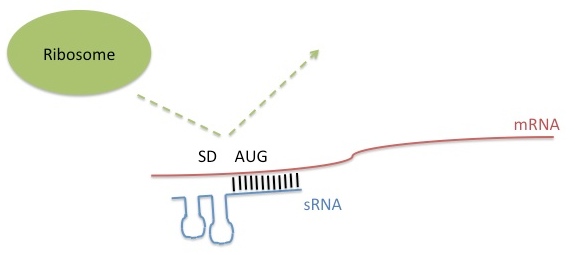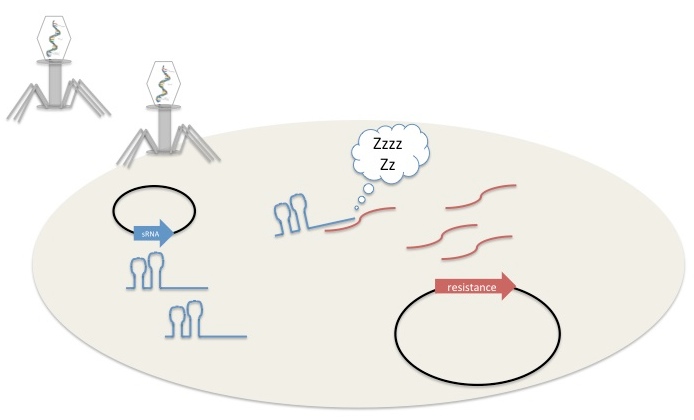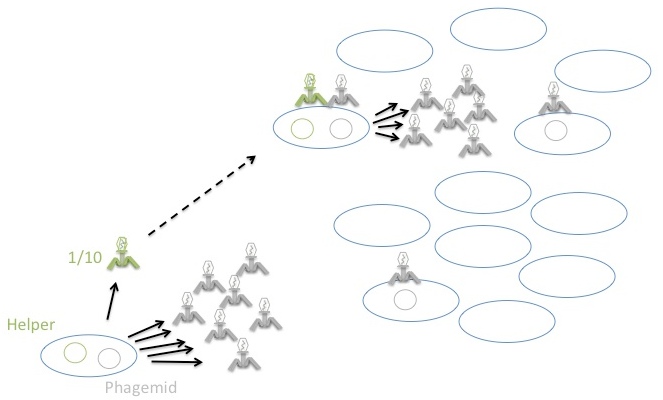Team:Paris Bettencourt/Project/Trojan Horse
From 2013.igem.org
| Line 4: | Line 4: | ||
<div id="page"> | <div id="page"> | ||
<h2> Introduction </h2> | <h2> Introduction </h2> | ||
| - | <p>Antibiotic resistance is wide | + | <p>Antibiotic resistance is wide spread in nature and is a major problem in the attempt to cure diseases such as tuberculosis. |
| - | Tuberculosis is an infectious disease that typically attacks lungs and which is caused by a mycobacterium called ''Mycobacterium Tuberculosis''. One third of the world's population is thought to have been infected by the mycobacterium. Moreover, in the past years, several strains of the bacterium carrying antibiotics resistance and | + | Tuberculosis is an infectious disease that typically attacks lungs and which is caused by a mycobacterium called ''Mycobacterium Tuberculosis''. One third of the world's population is thought to have been infected by the mycobacterium. Moreover, in the past years, several strains of the bacterium have been found carrying antibiotics resistance and are complicated to treat. The treatment against tuberculosis usually involves a consortium of antibiotics taken for 6-9 months due to persistance and resistance to individual medications. As a result it has become a major health problem most notably in developing countries where access to medication and adherence for such a long period can both be difficult. Our project aims to facilitate the treatment of the disease by making it easier to kill the antibiotics resistant strains of the mycobacterium.<br> |
<br> | <br> | ||
| - | + | Our idea is to embed a synthetic sRNA on a selfish DNA element such as a phage that spreads in a bacterial population and to use this construct to select against unwanted genes, in this case antibiotic resistance. The synthetic sRNA is a small RNA (24 bp) designed to bind to the first 24 base pairs of the mRNA of an antibiotic gene. We will target chloramphenicol resistance gene and / resistance gene for our proof of concept, using strain MG1655 of E.coli. Once the sRNA has bound, the ribosomes are unable to bind to the RNA which is then not translated into a protein. The cell is not producing the antibiotic resistance protein anymore and is easily killable using antibiotics. We also want to work on a construct in which we can repress a LacZ gene to be able to quantify the effectiveness of our synthetic sRNA construct. We aim to test several constructs, integrating the resistance or/and the synthetic sRNA construct in plasmid or/and in the chromosome of the bacterium as wild bacteria can have resistance both on chromosome and plasmid.<br> | |
| - | + | ||
| - | Our idea is to embed a synthetic sRNA on a selfish DNA element | + | |
| - | + | ||
| - | The synthetic sRNA is a small RNA (24 bp) designed to bind to the first 24 base pairs of the mRNA of an antibiotic gene. We will target chloramphenicol resistance gene and / resistance gene for our proof of concept, using strain MG1655 of E.coli. Once the sRNA has bound, the ribosomes are unable to bind to the RNA which is then not translated into a protein. The cell is not producing the antibiotic resistance protein anymore and is easily killable using antibiotics. | + | |
| - | + | ||
| - | We also want to work on a construct in which we can repress a LacZ gene to be able to quantify the effectiveness of our synthetic sRNA construct. | + | |
| - | + | ||
| - | We aim to test several constructs, integrating the resistance or/and the synthetic sRNA construct in plasmid or/and in the chromosome of the bacterium as wild bacteria can have resistance both on chromosome and plasmid.<br> | + | |
<br> | <br> | ||
<br> | <br> | ||
| Line 24: | Line 16: | ||
As pharmaceutical pipelines of antibiotics are drying up, our team has decided to investigate this alternative strategy.<br> | As pharmaceutical pipelines of antibiotics are drying up, our team has decided to investigate this alternative strategy.<br> | ||
<br> | <br> | ||
| - | First how can we open the wall of drug resistance? Drug resistance can be due to different mechanisms but a lot of them rely on the presence of protective proteins. They can be efflux | + | First how can we open the wall of drug resistance? Drug resistance can be due to different mechanisms but a lot of them rely on the presence of protective proteins. They can be efflux pump proteins that extract the antibiotics from the cell or they can be enzymes that quickly metabolize the antibiotic molecules to make them inactive. What is interesting is that this defense system, this wall, is made of certain proteins and therefore is encoded somewhere as DNA in the bacteria. If it is encoded somewhere in order to be transcribed into mRNA then translated into protein, there has to be a way to block their expression.<br> |
Our idea is to make use of a very simple regulatory mechanism that bacteria naturally use to silence certain of their own genes and that is based on small regulatory RNAs (sRNAs). In fact if a small piece of RNA binds to the Shine-Dalgarno area of a given mRNA, this simple interaction based on base pair complementarity can prevent the binding of the ribosome and thus completely block translation.<br> | Our idea is to make use of a very simple regulatory mechanism that bacteria naturally use to silence certain of their own genes and that is based on small regulatory RNAs (sRNAs). In fact if a small piece of RNA binds to the Shine-Dalgarno area of a given mRNA, this simple interaction based on base pair complementarity can prevent the binding of the ribosome and thus completely block translation.<br> | ||
<br> | <br> | ||
Revision as of 14:08, 9 August 2013
<body>
Introduction
Antibiotic resistance is wide spread in nature and is a major problem in the attempt to cure diseases such as tuberculosis.
Tuberculosis is an infectious disease that typically attacks lungs and which is caused by a mycobacterium called Mycobacterium Tuberculosis. One third of the world's population is thought to have been infected by the mycobacterium. Moreover, in the past years, several strains of the bacterium have been found carrying antibiotics resistance and are complicated to treat. The treatment against tuberculosis usually involves a consortium of antibiotics taken for 6-9 months due to persistance and resistance to individual medications. As a result it has become a major health problem most notably in developing countries where access to medication and adherence for such a long period can both be difficult. Our project aims to facilitate the treatment of the disease by making it easier to kill the antibiotics resistant strains of the mycobacterium.
Our idea is to embed a synthetic sRNA on a selfish DNA element such as a phage that spreads in a bacterial population and to use this construct to select against unwanted genes, in this case antibiotic resistance. The synthetic sRNA is a small RNA (24 bp) designed to bind to the first 24 base pairs of the mRNA of an antibiotic gene. We will target chloramphenicol resistance gene and / resistance gene for our proof of concept, using strain MG1655 of E.coli. Once the sRNA has bound, the ribosomes are unable to bind to the RNA which is then not translated into a protein. The cell is not producing the antibiotic resistance protein anymore and is easily killable using antibiotics. We also want to work on a construct in which we can repress a LacZ gene to be able to quantify the effectiveness of our synthetic sRNA construct. We aim to test several constructs, integrating the resistance or/and the synthetic sRNA construct in plasmid or/and in the chromosome of the bacterium as wild bacteria can have resistance both on chromosome and plasmid.
Starring: Helena, Clovis, Vincent, Aude, Anne
Storyline
In the war against infectious diseases, let’s consider molecules of antibiotics as soldiers and a bacteria as a city to defeat. Now what is a drug resistant bacteria? It’s a fortified city with a wall that protects it against armies. Two strategies remains in this case: 1) overpower the protective wall with an upgraded army containing new type of antibiotics. 2) enter the city disguised as friend and open the gates from the inside: the Trojan Horse subterfuge.
As pharmaceutical pipelines of antibiotics are drying up, our team has decided to investigate this alternative strategy.
First how can we open the wall of drug resistance? Drug resistance can be due to different mechanisms but a lot of them rely on the presence of protective proteins. They can be efflux pump proteins that extract the antibiotics from the cell or they can be enzymes that quickly metabolize the antibiotic molecules to make them inactive. What is interesting is that this defense system, this wall, is made of certain proteins and therefore is encoded somewhere as DNA in the bacteria. If it is encoded somewhere in order to be transcribed into mRNA then translated into protein, there has to be a way to block their expression.
Our idea is to make use of a very simple regulatory mechanism that bacteria naturally use to silence certain of their own genes and that is based on small regulatory RNAs (sRNAs). In fact if a small piece of RNA binds to the Shine-Dalgarno area of a given mRNA, this simple interaction based on base pair complementarity can prevent the binding of the ribosome and thus completely block translation.

We have designed sRNAs that binds to drug resistance genes in E. coli and thus are able to make a bacteria sensitive again to classical antibiotics.
Now we have a way to open the protective wall… from the inside. So how do we get inside the bacteria without being noticed?
In nature there is a form of life that is specialized in getting inside bacteria to manipulate them and take advantage of their resources: Phages. However those are not exactly considered as gifts by bacteria… they are usually impairing bacteria if not killing them. Interestingly, a modified version of the M13 phage is able to package DNA into the empty body of a phage and thus carry a given DNA sequence into a bacteria instead of the natural phage’s DNA. Those DNA sequences packaged into phages body are called phagemids. This phenomena is particularly interesting from the perspective of our project because we could put the DNA sequence of our sRNA into one of those phagemids and thus infect bacteria without inflicting it the burden of a real phage infection. As our DNA sequence would not code for any protein but simply be transcribed into sRNA, the fitness of the bacteria would not be impaired in the beginning. Then of course once the trap is set up and the resistance genes silenced, we would let the army of antibiotics enter a defenseless bacteria.

Another interesting feature of such a system is its capacity to autonomously propagate from bacteria to bacteria. Phagemids are produced if the DNA sequence you want to package has got a M13 packaging signal in it and is in a bacteria that contains a special plasmid called Helper phage plasmid. This Helper phage plasmid is in fact the complete circular DNA of a natural M13 but with mutations in its origin of replication that make it less able to package its DNA into the phage body thus resulting in the packaging of the DNA sequence of your choice instead. Therefore we call a cell containing both our DNA sequence (containing the sRNA) and the helper phage plasmid a phagemid factory cell. The interesting point is that from time to time the helper phage plasmid gets packaged anyway and is thus able to convert another cell into a phagemid factory cell.

 "
"







 +33 1 44 41 25 22/25
+33 1 44 41 25 22/25


